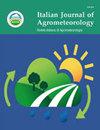Assessment of deficit irrigation impact on agronomic parameters and water use efficiency of six chickpea (Cicer Arietinum L.) cultivars under Mediterranean semi-arid climate
IF 0.8
4区 农林科学
Q2 AGRONOMY
Italian Journal of Agrometeorology-Rivista Italiana Di Agrometeorologia
Pub Date : 2021-12-27
DOI:10.36253/ijam-1261
引用次数: 1
Abstract
Six kabuli chickpea genotypes (Cicer Arietinum L.) were evaluated under three water levelss at the open field during February -June 2018. This study was conducted to evaluate the chickpea water stress, on soil water dynamic, agromorphological traits, and water use efficiency to estimate variability levels between varieties and to identify the varieties of chickpea adaptable on semi-arid bioclimatic stage. For this purpose, a trial was conducted at the Higher Agronomic Institute of Chott Mariem (Tunisia). There is no effect of the treatment on the height, biological yield, and branching number. The seeds weigh, PCG, seed yield, harvest index, and water use efficiency relative to seed have the highest value in T1 (100% of ETc) when water use efficiency relative to biological yield, number of pods and of seeds recorded the highest values in T3 (50% of ETc). Univariate analysis showed highly significant differences between genotypes for many traits. Principal Component Analysis was performed for all traits and allowed to define two axes. The first one explains 49.30% of the variability of the total trait and was formed by genotypes ‘Beja’, ‘Nayer’ and’ ‘Rebha’. Genotypes forming this axe are closely related to each other according to their common morphological characters like height (r=0.88), biological yield (r=0.93), bringing the number (r=0.53), seed yield (r=0.81), WUE relative to seed (r=0.75), harvest index (r=0.65) and WUE relative to biological yield (r=0.94). The second clustered genotypes ‘Bochra’ and ‘Nour’. This second axe (27.99%) is represented by pods number (r=0.87), seed number (r=0.87) and PCG (r=0.78).地中海半干旱气候下亏水灌溉对6个鹰嘴豆品种农艺参数和水分利用效率的影响
2018年2月至6月,在开阔地的三个水位下对六种卡布力鹰嘴豆基因型(Cicer Arietinum L.)进行了评估。本研究旨在评估鹰嘴豆的水分胁迫、土壤水分动态、农业形态特征和水分利用效率,以估计品种之间的变异水平,并确定适合半干旱生物气候阶段的鹰嘴豆品种。为此,在Chott Mariem高等农业研究所(突尼斯)进行了一项试验。处理对高度、生物产量和分枝数没有影响。种子重量、PCG、种子产量、收获指数和相对于种子的水分利用效率在T1中具有最高值(ETc的100%),而水分利用效率相对于生物产量、荚数和种子数在T3中记录最高值(ETc的50%)。单变量分析显示,许多性状的基因型之间存在高度显著差异。对所有性状进行主成分分析,并允许定义两个轴。第一个解释了49.30%的总性状变异,由基因型“Beja”、“Nayer”和“Rebha”形成。形成该斧的基因型根据其共同的形态特征(如高度(r=0.88)、生物产量(r=0.93)、带数(r=0.53)、种子产量(r=0.81)、WUE相对于种子(r=0.75)、收获指数(r=0.65)和WUE相对于生物产量(r=0.94))而密切相关。第二轴(27.99%)由荚数(r=0.87)、种子数(r=0.77)和PCG(r=0.78)表示。
本文章由计算机程序翻译,如有差异,请以英文原文为准。
求助全文
约1分钟内获得全文
求助全文
来源期刊

Italian Journal of Agrometeorology-Rivista Italiana Di Agrometeorologia
AGRONOMY-ENVIRONMENTAL SCIENCES
CiteScore
2.10
自引率
8.30%
发文量
6
期刊介绍:
Among the areas of specific interest of the journal there are: ecophysiology; phenology; plant growth, quality and quantity of production; plant pathology; entomology; welfare conditions of livestocks; soil physics and hydrology; micrometeorology; modeling, simulation and forecasting; remote sensing; territorial planning; geographical information systems and spatialization techniques; instrumentation to measure physical and biological quantities; data validation techniques, agroclimatology; agriculture scientific dissemination; support services for farmers.
 求助内容:
求助内容: 应助结果提醒方式:
应助结果提醒方式:


